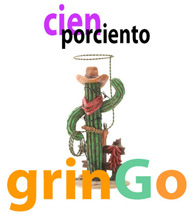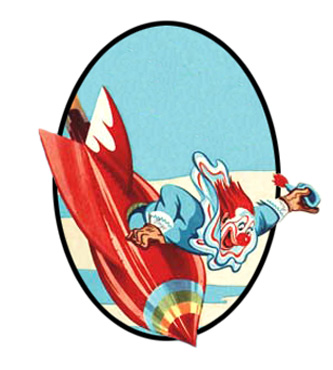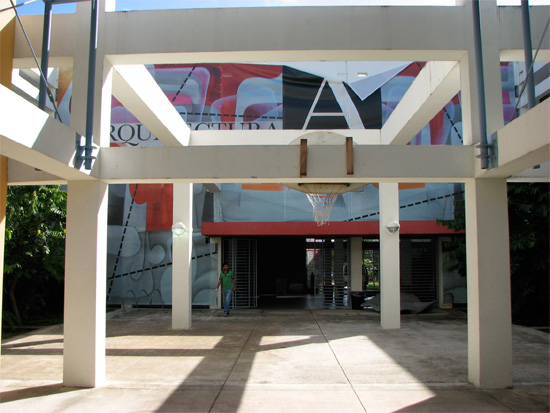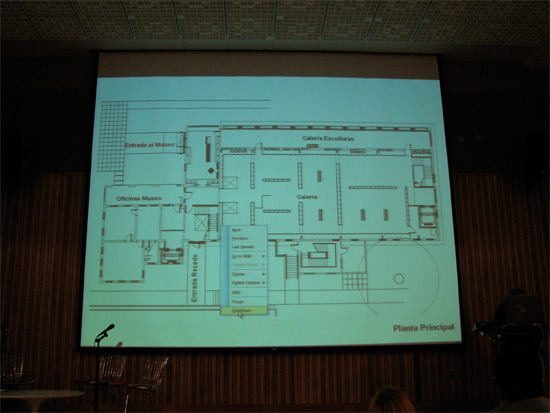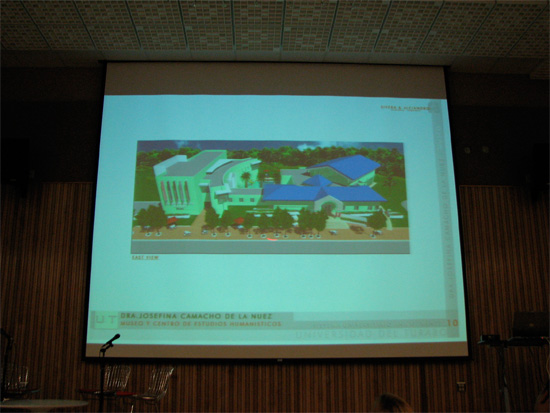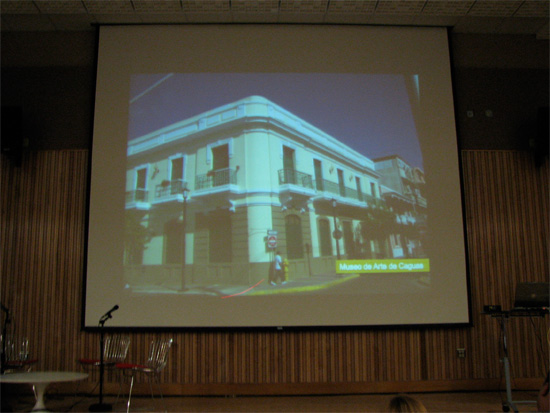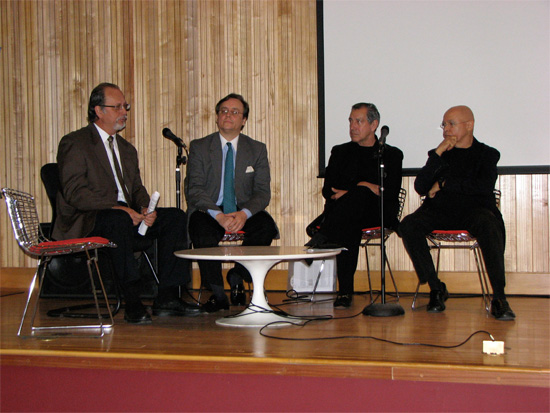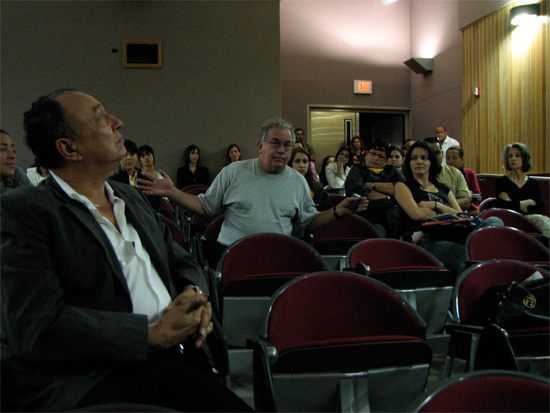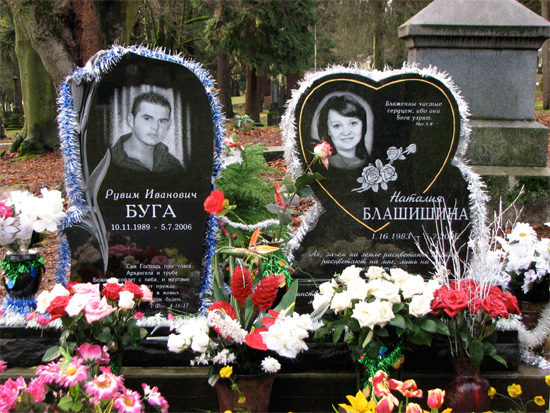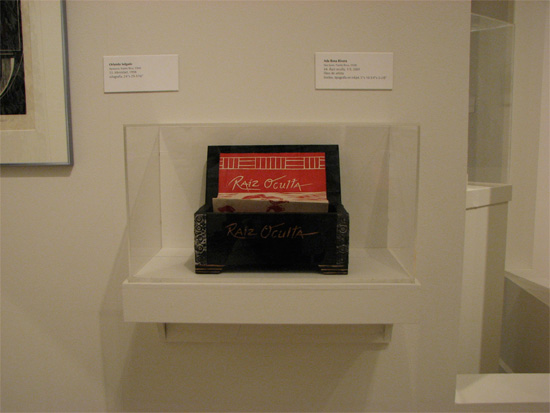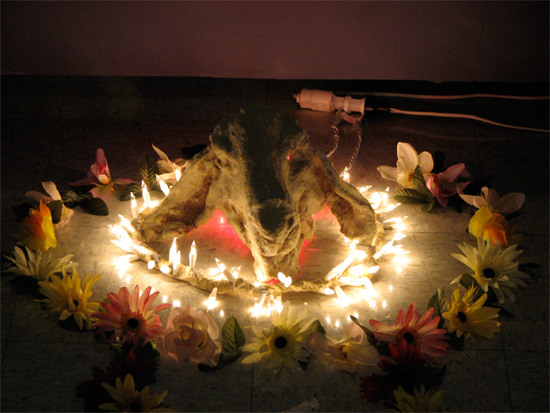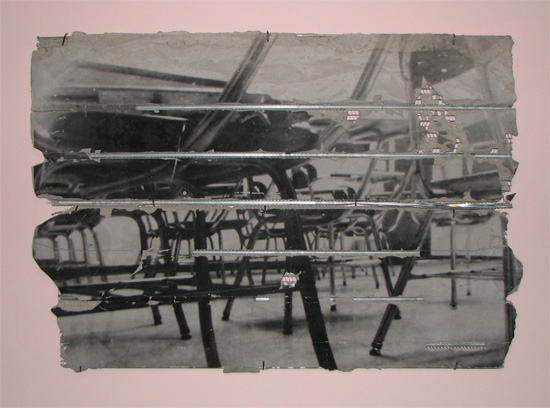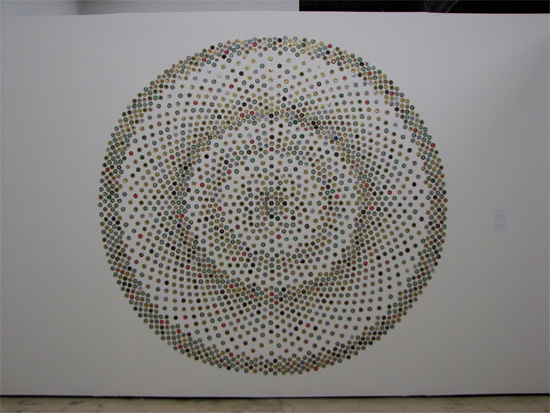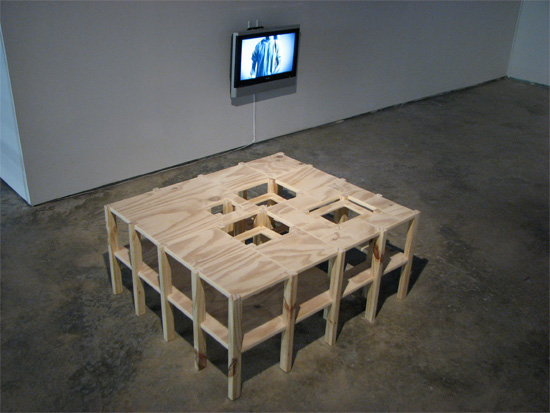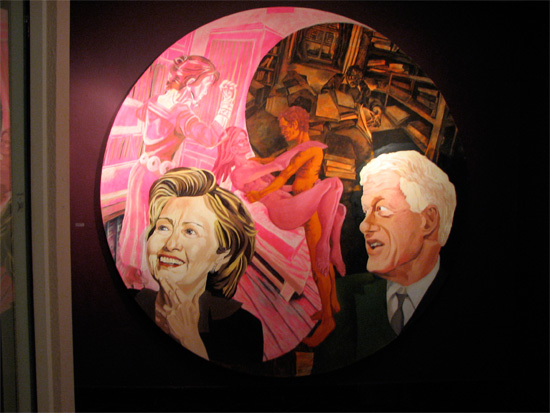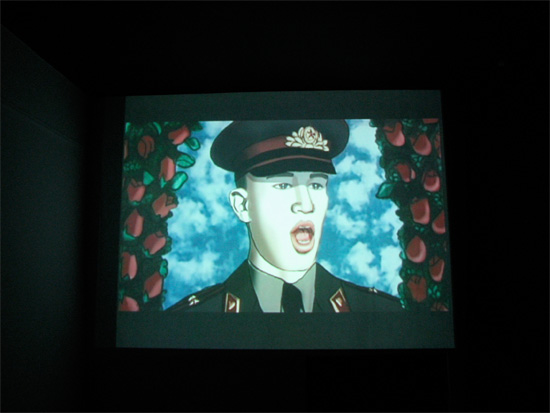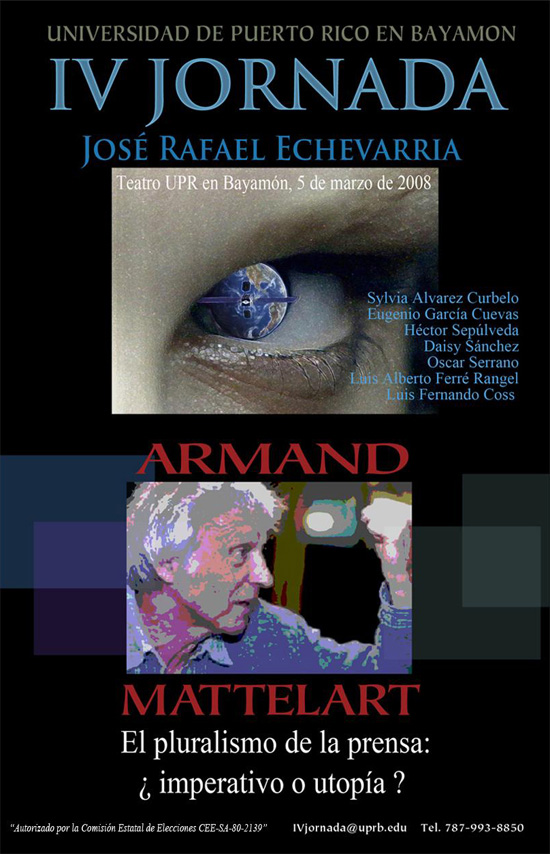|
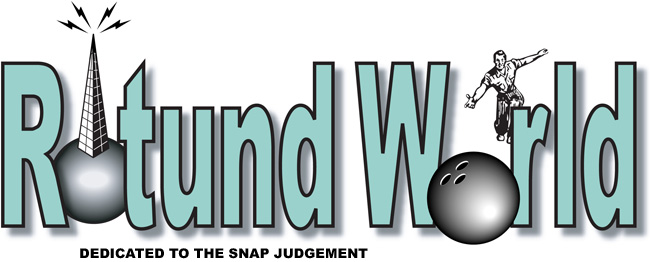
We Want to Love You til It Hurts
Whoooeeee! It certainly is a hot time in the old town tonight. The great Museo de Arte Contemporáneo (MAC) “crisis” of 2008 shows no signs of abating. Not because of any concrete, measurable, or even slightly reasonable factors in the institution’s financial condition. For all anyone knows, the MAC directorate had its march, got what it wanted from the island legislature—a promise of a two-fold increase in government funding—and apart from noisome quacking from the expected quarters, business probably would have returned to something like normal within a matter of days. But apparently not. Folks are waxing apoplectic from every seething artworld slough and crevice, around the clock. The racket of colliding self-interest, personal agendas, and wishful thinking continues to echo in the tiny confines of the San Juan artworld like kabooming ack-ack from a forgotten imperial war. Not one to leave well enough alone, Mario “Cap’n Queeg” Alegre Barrios, the cultural commander of that leaky old frigate of daily papers, El Güevo Día, made the ill-advised decision to invite the most polarized figures of the MAC controversy to a closed-door “roundtable” discussion at the paper. The resulting several column inches of barely concealed sniping, thin-lipped condescension, and rancorous chin-thrusting—which the deluded editor described as a “reconciliation of stances which, after all, are not so radically opposed”—threw a little gasoline on the fire, but that was nothing compared to what Alegre Barrios did next. On successive days he ran fullpage fullisades by artist Rafael Trelles—representing, in horrified terms, the position of a museum believing itself under attack by hordes of frothing, uncouth nihilists—and Beatriz Santiago, who reiterated her own unwavering conviction that the present directorate of the museum has to go in order for any significant changes to unfold as the institution grapples with its future. As far as we can see, the only upshot of all of this heavy breathing has been the appearance of contending petitions on a website which pleads thousands and thousands of cases every day, including those of otters, bobcats, the Prophet, “Yes to Christmas, no to holidays,” and some avid youths who want to “see the Jonas Brothers do the Crank Dat Jo Bro.” It strikes us as a tad pathetic and overwrought por mucho, so excuse us, we’re on to other things. (For those who lack for easy amusement—or perhaps you have the silly idea that Rotund World overstates the case—here’s a link to a downloadable document which contains the text of the so-called roundtable at El Güevo Día.)
The truth is there have been considerably higher-tone doings in the San Juan artsphere in the last little while, completely free of costumed characters, chanting multitudes, and furious blather. A few weeks ago, for example, we ambled over to the architecture school auditorium at our neighborhood university campus—Universidad de Puerto Rico (UPR), Rio Piedras—and spent a relatively pleasant morning at a conference dubbed “Future Museums in Puerto Rico.” Rather than disputatious art yokels lobbing raspberries at each other in cybersapce, this event brought together three live, bona fide architects to discuss art museum projects they have—or have had—underway in Puerto Rico. The guests included Jaime Cobas, designer of the combined art musuem and academic senate at the University of Puerto Rico in Mayagüez; Warren James, a New York artchitect who oversaw the rennovation of the municipal art museum in Caguas; and Héctor Rivera, architect of the art museum and humanities center at the University of Turabo. Luis Gutiérrez was supposed to speak about the ongoing renovation of Museo de Arte de Ponce’s famed Edward Durrell Stone building, but he couldn’t attend. In his place, Otto Reyes took the dais during the question-and-answer period. In light of the acrimonious huffing and puffing that constitutes most conversations about museums these days, it was a vast relief to spend a few hours in such a collegial setting, listening to informative chitchat about projects the speakers clearly loved and knew something about.
It must have been tough for each architect to boil many months’ worth of thinking and planning down to a half-hour PowerPoint lecture, and the speakers’ presentations were necessarily limited, if not quite breezy enough. A friend of ours later criticized the architects for focusing too much on the museums’ exhibition spaces, neglecting for the most part the institutions’ other, equally important functions as centers of education, conservation, and community service.
But shoot, architects are so notably buttoned-down and grand-scheming that we forgave them all for being relatively brief. On the plus side, each project presented a kind of challenge to the architect, and their solutions, judging from the slides, involved the more or less ingenious surmounting of budget constraints, perservation concerns, and scant resources. The site for Rivera’s building was heavily wooded, and he wanted to adapt the bulding as much possible to the landscape. Cobas and James worked with exisiting, historically significant buildings, and both meant to incorporate something of the past in their considerable reshaping of history. Whatever the realities of the architects’ accomplishments, the discussion was generally expansive and upbeat, and we heard a not-unusual quota of architectural wisdom. Having created a contemporary exhibition space with—of all things—a colonnaded gallery and niches, Cobas was quick to point out that “the historic and the contemporary have always coexited,” a variation on the theme that everything we think of as classical or modern was, in its own day, contemporary. Rivera remarked that art musems are “permanently in service to the public,” meaning that such buildings must have a built-in flexibility, designed to last long into the future.
If there was anything resembling a wild card in this sober-sided group, it was Warren James. James broke up the relatively snoozy succession of plan views and architectural renderings with some images only obliquely related to the Caguas museum—including a clip of artist Doug Aitken’s latest installation, Sleepwalkers, a spectacular video projection on the exterior walls of New York City’s Museum of Modern Art—and he threw in a couple of cogent observations which we found especially appropriate for the perpetually anemic cultural metabolism of Puerto Rico. The first was that museums facing restraints of any kind can do a lot with what they have. New York’s Metropolitan Museum, for example, hemmed in on all sides by the territorial limitations of Central Park, now builds upward or downward or simply rearranges its interior spaces to accomodate new works. James also presented the novel idea of a “visitable vault” of works in storage, in which museums allow visitors access to the unexhibited part of their collections. Perhaps this is not such a good idea for institutions with haphazard—or non-existent—collecting policies, but what a treat for the general public in ordinary circumstances. Houston’s venerable Menil Collection, for one, always has far more juicy stuff in its back rooms than what’s on display.
The question-and-answer period was peppered with half-articulated excalmations and wild gesticulations coming from the peanut gallery and some ponderous generalizations from the dais, mostly about how the dwarfish concerns of museum curators and conservators impede the full flowering of architects’ genius. Architect Luis Flores put in his two cents’ worth from the floor about what he called “the Bilbao effect”—named after the Frank Gehry-designed Guggenheim Museum—which is, according to Flores, a baleful, peculiarly contemporary phenomenon in which museums are considered as anchors for vast urban renewal projects, and their designs develop according to the needs of urban planning rather than the imperatives of exhibiting and conserving art. Could be. Why do goats eat tin cans?
The morning’s only note of harrumphing came from Warren James. “Future Museums in Puerto Rico” was officially sponsored by the visual arts program of the Insitute of Puerto Rican Culture (ICP)—thanks again, Elaine Delgado—but it was James who conceived of the idea and organized the conference. He wondered aloud why someone—or some institution —here in Puerto Rico didn’t do it, and, well, why indeed?
Speaking of things architectural, for weeks and weeks we’ve been dying to show you a few very snazzy things we like about Portland, Oregon, where we went for our Christmas holidays. You’ve no doubt heard about the rain and the hippies and the volcanos, but those are minor annoyances when compared to the city’s surpassing loveliness. Actually, the hippies are part of the charm, like colorful garden gnomes scattered amidst the tall firs. The idea is to visit public art projects and private memorials, with a sidelong glance at something peculiarly Oregonian, the Lone Fir Cemetery. Lone Fir is the resting place of an astonishing variety of those who’ve come to be the city’s natives: along with pioneers and their descendants, there are Russians, Cambodians, Japanese, and Chinese whose families immigrated—some of them generations ago—and stayed. This is the closest thing the Pacific Northwest has to el entierro de la sardina, and we’re hoping our boricua friends can relate. But wait. Isn’t Rotund World supposed to be about Porto Rico? Didn’t we just assure you that there’ve been a passel of “considerably higher-tone doings in the San Juan artsphere in the last little while”? Yes, and yes again. For one thing, we’ve always believed in art as moral uplift, its salutary effect on the soul, and all that other crap that people say when they don’t know what they’re talking about. Anyhoo, it doesn’t really hurt the clodhoppers to see pretty pictures about what’s going on in other parts, so pay attention.
As for local doings, we’ll leave those in the indelicate hands of Pedro Vélez, who has recently provided buckets of bilgewater and some outright claptrap regarding the exhibition of recent acquisitions at Museo de Historia, Antropología y Arte on UPR’s Rio Piedras campus, and a show by some young printmakers at the nearby Galería Francisco Oller, titled [clave] once. Vélez also bites hard into the ICP’s Estigma at La Ballajá. We would never say that Vélez is a complete knucklehead and a bigtime loser, because frankly we don’t understand what he’s talking about half the time. Dark, frequently spanglicized insinuation seems to the man’s favorite critical instrument, and it’s a blunt one. You may see the point, but we believe you’re ahead to skip over the muttering and go straight for the plentiful images. Better yet, we highly recommend a visit to Museo de Historia, Antropología y Arte. We regard Flavia Marichal’s curatorial hand as smart, discriminating, and—befitting a historical institution—culture-minded in the broadest sense. The museum is open Monday, Tuesday, and Friday from 9 a.m. to 4:30 p.m., Wednesday and Thursday from 9 to 8:30 p.m., and Sunday from 11:30 a.m. to 4:30 p.m. It’s located just behind the University Station of the Tren Urbano, and admission is free. Call 787-764-0000, extension 2456 or 2452 for information, or email the museum here.
Galería Francisco Oller is very nearby the museum, but it’s a complete mystery to us how you go about viewing [clave] once. Which is a big shame because it’s a good show of young artists with skills to back up their gumption. Omar Velázquez organized the show and he’s in it, so you might luck out by finding him and asking politely for a tour. Getting back to Vélez, his dank take on Estigma likewise escapes us. Why not hie on down to La fab Ballajá and judge for yourself. Unlike Pedro, we think Miguel Luciano is a pip. And any time Calle 13’s El Residente warbles—as he does during Allora and Calzadilla’s Estigma video—we listen. Be warned, in the best of circumstances the Museo de las Américas—where the exhibition resides—closes when you least expect it—something like four o’clock in the afternoon—and the ICP website says the show has already ended. But call the ICP at (787) 724-0700 and see if you can avoid getting completely ensnarled in the cultural bureaucracy and end up talking to a real human being who has something useful to say.
What Vélez has not yet talked about, though others have, is the new installation at Espacio 1414, the exhibition warehouse of the Berezdivin collection, where cuartor Julieta González is in charge of the rotating shows. González gives us a new three-fer: Notas sobre la abstracción on the first floor; Diálogos 7 on the second floor, consisting of new works by Ada Bobonis which generally follow in the path of her recent wood and photography installation at Museo de Arte de Puerto Rico; and on the third floor a tongue-twister of a show which is best expressed by its subtitle, Abandona tu mente and recobra tus sentidos. It includes works by Hélio Oiticica, Lygia Clark, and Ernesto Neto, which gives you a good idea about how very groovy it is.
We breezed through all three exhibitions on the day we visited, so an in-depth look will have to wait for another time. Meanwhile, we hope some images will encourage you to visit the Berezdivin’s, possibly one of the best places on the island to learn about the breadth of global art as it’s being practiced today. The warehouse is located at Avenida Fernández Juncos 1414 in Santurce, and you can reach Ms. González by calling 787-725-3899 or emailing her here. The website features a downloadable map and other useful information. In general the space is open from 2 p.m. to 6 p.m. on Saturdays, but if you call ahead and the roving curator is in town, you’re likely to get an appointment at your convenience.
Did we mention that Galería 356 had an opening while we weren’t looking? It’s a group show of gallery artists, but as usual there’s a lot to like about director Michele Fiedler’s program. Plentiful works by Christopher Rivera, including a big print-and-drawing whose name Christopher had to whisper to us. We always like seeing new paintings from the dextrous hands of Nathan Budoff, and there’s an animation in the center gallery by, forgive us, an artist whose name we failed to take note of. Have we no shame? You’ll just have to drop by the gallery before the old stuff disappears and new stuff takes its place. Galería 356 is located at Calle César González 356 and it’s usually open like clockwork. Call 787-282-7820 to make sure, or visit the 356 website. It’s informative and easy to navigate. Goodness! Look at the time. We’ve gone on and on and still haven’t reached Oregon. Come back in a few days, and we promise a look at that storybook place. Meantime, traipse on over to our previous episode to see what the fuss is about. CalendarioOops! We promised Margarita Fernández Zavala we’d call your attention to the following conference relating to those vital, frequently knotty issues surrounding the written word. It takes place on March 5 at UPR in Bayamón and features French theorist Armand Mattelart.
|
